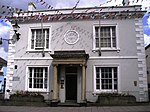Marlwood School
1606 establishments in EnglandAcademies in South Gloucestershire DistrictEducational institutions established in the 1600sSecondary schools in South Gloucestershire DistrictUse British English from February 2023

Marlwood School (founded 1606) is a state-funded secondary school currently part of the CSET academy chain. Located at Alveston, South Gloucestershire, it is situated on the B3561 on the outskirts of the south-west of the village. Marlwood School has around 500 pupils aged 11–16. In its most recent Ofsted inspection, Marlwood was rated ‘Requires Improvement’ overall and ‘Good’ in 3 out of 4 measures, with the report noting that the school ‘is enjoying a new lease of life.’
Excerpt from the Wikipedia article Marlwood School (License: CC BY-SA 3.0, Authors, Images).Marlwood School
Vattingstone Lane, Bristol Alveston
Geographical coordinates (GPS) Address Website External links Nearby Places Show on map
Geographical coordinates (GPS)
| Latitude | Longitude |
|---|---|
| N 51.5931 ° | E -2.5391 ° |
Address
Marlwood School
Vattingstone Lane
BS35 3LA Bristol, Alveston
England, United Kingdom
Open on Google Maps






